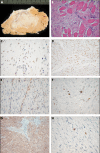Immunohistochemical analysis of desmoid tumours
- PMID: 16254103
- PMCID: PMC1770757
- DOI: 10.1136/jcp.2005.026278
Immunohistochemical analysis of desmoid tumours
Abstract
Background/aims: Although the standard treatment for desmoid tumours is complete surgical resection with wide margins, the optimal adjuvant treatment for recurrent or inoperable disease is unclear, often being based on sporadic immunohistochemical reports with a low number of cases. Therefore, a large immunohistochemical study was performed, to provide a theoretical basis for adjuvant treatment regimens.
Methods: One hundred and sixteen tissue samples from 80 patients (49 female, 31 male; mean age, 34 years; range, 0-83) with desmoid tumours (46 extra-abdominal, 21 abdominal, 13 intra-abdominal) were tested for oestrogen receptors alpha and beta, progesterone and androgen receptors, and somatostatin, in addition to HER2, cathepsin D, Ki-67, and c-KIT by immunohistochemistry.
Results: All samples were negative for oestrogen receptor alpha, HER2, and the progesterone receptor. Positive staining for the androgen receptor was found in six extra-abdominal cases. Staining for oestrogen receptor beta was positive in four extra-abdominal, two abdominal, and one intra-abdominal case. Staining for somatostatin was positive in six extra-abdominal, two abdominal, and one intra-abdominal case, and staining for cathepsin D was positive in all cases. Positive staining for Ki-67 was found in 14 extra-abdominal, three abdominal, and three intra-abdominal cases. C-KIT was detectable in one abdominal case only.
Conclusions: The data from this immunohistochemical study show that the published effects of antioestrogens and imatinib mesylate in the treatment of aggressive fibromatoses may not be attributable to oestrogen receptor alpha or c-KIT expression.
Figures


Similar articles
-
Is wide resection obsolete for desmoid tumors in children and adolescents? Evaluation of histological margins, immunohistochemical markers, and review of literature.Pediatr Hematol Oncol. 2015 Feb;32(1):60-9. doi: 10.3109/08880018.2014.956905. Epub 2014 Sep 29. Pediatr Hematol Oncol. 2015. PMID: 25264623 Review.
-
The role of imatinib mesylate in adjuvant therapy of extra-abdominal desmoid tumors.Anticancer Res. 2007 Mar-Apr;27(2):1143-7. Anticancer Res. 2007. PMID: 17465254
-
Factors predicting local recurrence of desmoid tumours including proliferating cell nuclear antigen.Aust N Z J Surg. 1999 Nov;69(11):782-9. doi: 10.1046/j.1440-1622.1999.01695.x. Aust N Z J Surg. 1999. PMID: 10553966
-
Desmoid-type fibromatoses involving the brachial plexus: treatment options and assessment of c-KIT mutational status.J Neurosurg. 2006 May;104(5):749-56. doi: 10.3171/jns.2006.104.5.749. J Neurosurg. 2006. PMID: 16703880
-
Molecular Pathogenesis of Sporadic Desmoid Tumours and Its Implications for Novel Therapies: A Systematised Narrative Review.Target Oncol. 2022 May;17(3):223-252. doi: 10.1007/s11523-022-00876-z. Epub 2022 Apr 21. Target Oncol. 2022. PMID: 35446005 Free PMC article. Review.
Cited by
-
[Pediatric tumors with spindle cell morphology].Pathologe. 2019 Jul;40(4):381-392. doi: 10.1007/s00292-019-0602-7. Pathologe. 2019. PMID: 31049678 Review. German.
-
Positron emission tomography as a surrogate marker for evaluation of treatment response in patients with desmoid tumors under therapy with imatinib.Biomed Res Int. 2013;2013:389672. doi: 10.1155/2013/389672. Epub 2013 May 16. Biomed Res Int. 2013. PMID: 23762842 Free PMC article. Clinical Trial.
-
Evolving strategies for management of desmoid tumor.Cancer. 2022 Aug 15;128(16):3027-3040. doi: 10.1002/cncr.34332. Epub 2022 Jun 7. Cancer. 2022. PMID: 35670122 Free PMC article. Review.
-
Signal transduction pathway analysis in fibromatosis: receptor and nonreceptor tyrosine kinases.Hum Pathol. 2012 Oct;43(10):1711-8. doi: 10.1016/j.humpath.2011.12.021. Epub 2012 Apr 18. Hum Pathol. 2012. PMID: 22520949 Free PMC article.
-
Long-term outcome of sporadic and FAP-associated desmoid tumors treated with high-dose selective estrogen receptor modulators and sulindac: a single-center long-term observational study in 134 patients.Fam Cancer. 2016 Jan;15(1):31-40. doi: 10.1007/s10689-015-9830-z. Fam Cancer. 2016. PMID: 26275868
References
-
- Goldblum J, Fletcher JA. Desmoid type fibromatoses. In: Fletcher CDM, Unni KK, Mertens F, eds. World Health Organisation classification of tumours. Pathology and genetics of tumours of soft tissue and bone. Lyon: IARC, 2002:83–4.
-
- Reitamo JJ, Scheinin TM, Hayry P. The desmoid syndrome. New aspects in the cause, pathogenesis and treatment of the desmoid tumor. Am J Surg 1986;151:230–7. - PubMed
-
- Leithner A, Gapp M, Leithner K, et al. Margins in extra-abdominal desmoid tumors: a comparative analysis. J Surg Oncol 2004;86:152–6. - PubMed
-
- Hansmann A, Adolph C, Vogel T, et al. High-dose tamoxifen and sulindac as first-line treatment for desmoid tumors. Cancer 2004;100:612–20. - PubMed
MeSH terms
Substances
LinkOut - more resources
Full Text Sources
Research Materials
Miscellaneous
